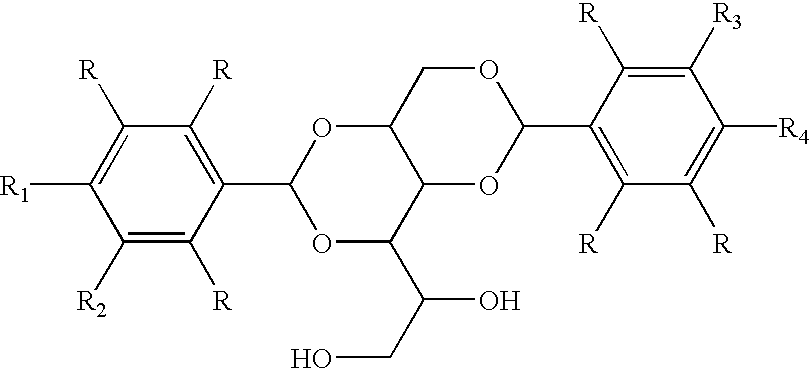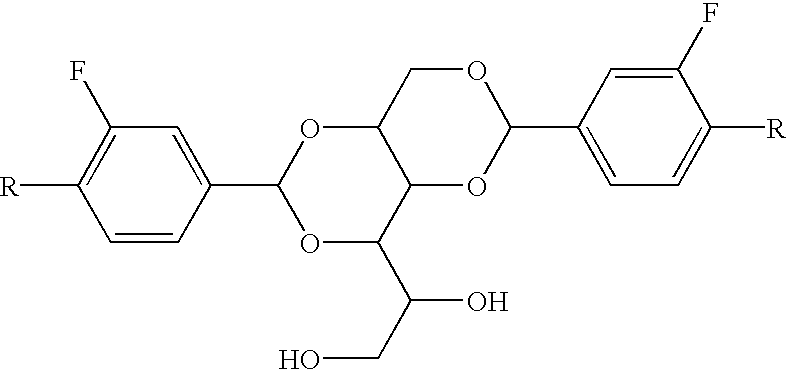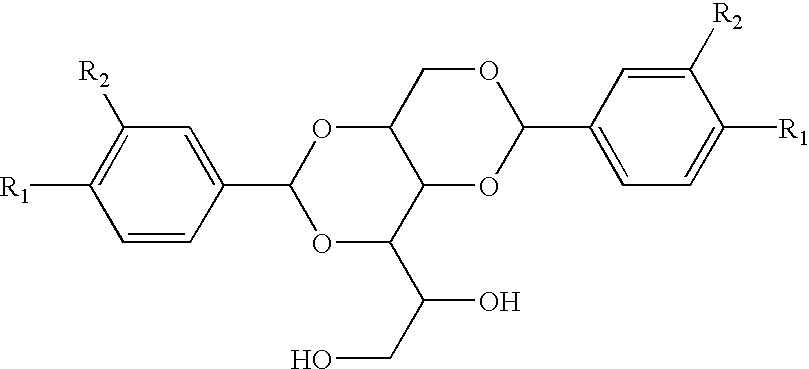Novel asymmetric substituted benzaldehyde alditol derivatives and compositions and articles containing same
a technology of benzaldehyde alditol and derivatives, which is applied in the field of new asymmetric substituted benzaldehyde alditol derivatives and compositions and articles containing same, and can solve the problem of difficult separation of individual compounds from reaction product mixtures
- Summary
- Abstract
- Description
- Claims
- Application Information
AI Technical Summary
Problems solved by technology
Method used
Image
Examples
example 1
Preparation of 4-t-butyl3,4-dimethyl DBS
[0031] D-Sorbitol (27 g, 0.15 mol), cyclohexane (500 mL), 4-t-butylbenzaldehyde (24 g, 0.15 mol), 3,4-dimethylbenzaldehyde (20 g, 0.15 mol), methanol (80 mL), water (2.5 g) and p-toluenesulfonic acid (3.0 g, 16 mmol) were added to a 2 L reaction kettle fitted with a mechanical stirrer, Dean-Stark trap with condenser and a thermometer. The system was flushed with argon and heated in an oil bath to reflux for 7 h. The methanol / water layer was continuously drained from the reaction system. Methanol was added as needed. The reaction mixture was cooled to room temperature and neutralized with KOH. The gray gel-like solid was filtered, washed three times with cyclohexane and dried in a vacuum oven to give mixture of 1,3;2,4-diacetal compounds determined through Infrared Spectroscopy, Gas Chromatography / Mass Spectrometry, .sup.1H NMR, and C.sup.13 NMR, all collectively hereinafter referred to as "standard analyses", to be an asymmetric mixture of 1,3...
example 2
Preparation of 3,4-dimethoxy / 3,4-dimethyl DBS
[0032] A two liter four-necked cylindrical shaped reaction flask equipped with a Dean-Stark trap, condenser, thermometer, nitrogen inlet, and a mechanical stirrer was charged with 42 g of sorbitol (0.23 mol), 2.5g of water, 80 mL of methanol, 38 g of 3,4-dimethoxybenzaldehyde (0.23 mol), 31g of 3,4-dimethylbenzaldehyde (0.23 mol), 3.3 g of p-toluenesulfonic acid and 700 mL of cyclohexane. The system was flushed with argon and heated in an oil bath to reflux for 5 h. The methanol / water layer was continuously drained from the reaction system. Methanol was added as needed. The reaction mixture was cooled to room temperature and neutralized with KOH. Water was then added and the cyclohexane layer was then stripped azeotropically, leaving a white solid collected by filtration. After washing with boiling water and boiling methanol, the result was a 3,4-dimethoxy / 3,4-dimethyl asymmetric DBS mixture determined through standard analyses by gas c...
example 3
Preparation of 4-isopropyl / 3, 4-dimethyl DBS
[0033] D-Sorbitol (27 g, 0.15 mol), cyclohexane (500 mL), 4-isopropylbenzaldehyde (22 g, 0.15 mol), 3,4-dimethylbenzaldehyde (20 g, 0.15 mol), methanol (80 mL) and water (2.5 g) were added to a 2 L reaction kettle fitted with a mechanical stirrer, Dean-Stark trap with condenser and a thermometer. The system was flushed with argon and heated in an oil bath to reflux for 7 h. The methanol / water layer was continuously drained from the reaction system. Methanol was added as needed. The reaction mixture was cooled to room temperature and neutralized with KOH. The gel-like solid was filtered, washed one time with cyclohexane and dried in a vacuum oven to give mixture four 1,3 ;2,4-diacetal compounds determined through standard analyses to be an asymmetric mixture of 1,3-O-(4-isopropylbenzylidene):2,4-O-(3,4-dimethylb-enzylidene) sorbitol and 1,3-O-(3, 4-dimethylbenzylidene)-2,4-O-(4-isoprop-ylbenzylidene) sorbitol (39%), 10% of bis(4-isopropylb...
PUM
| Property | Measurement | Unit |
|---|---|---|
| transparency | aaaaa | aaaaa |
| temperature | aaaaa | aaaaa |
| length/diameter | aaaaa | aaaaa |
Abstract
Description
Claims
Application Information
 Login to View More
Login to View More - R&D
- Intellectual Property
- Life Sciences
- Materials
- Tech Scout
- Unparalleled Data Quality
- Higher Quality Content
- 60% Fewer Hallucinations
Browse by: Latest US Patents, China's latest patents, Technical Efficacy Thesaurus, Application Domain, Technology Topic, Popular Technical Reports.
© 2025 PatSnap. All rights reserved.Legal|Privacy policy|Modern Slavery Act Transparency Statement|Sitemap|About US| Contact US: help@patsnap.com



